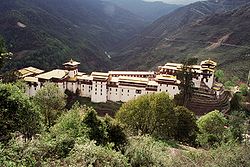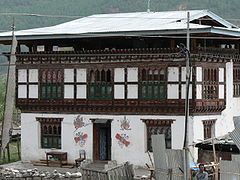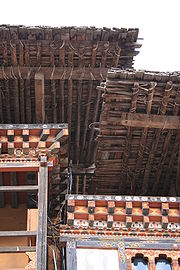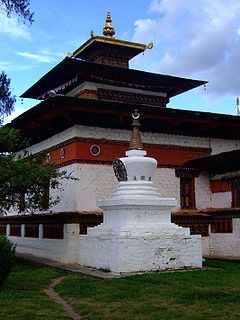
Architecture of Bhutan
Encyclopedia

Dzong architecture
Dzong architecture is a distinctive type of fortress architecture found in the present and former Buddhist kingdoms of the Himalayas: Bhutan and Tibet...
and everyday varieties. Dzongs in Bhutan
Bhutan
Bhutan , officially the Kingdom of Bhutan, is a landlocked state in South Asia, located at the eastern end of the Himalayas and bordered to the south, east and west by the Republic of India and to the north by the People's Republic of China...
were built as fortresses have served as religious and administrative centers since the 17th century. Secular lordly houses emerged as a distinct style in the late 19th century during a period of relative peace in Bhutan. Throughout its history, Bhutan has mainly followed the Tibetan tradition
Tibetan Buddhist architecture
Tibetan Buddhist architecture, in the cultural regions of the Tibetan people, has been highly influenced by Nepal, China and India. For example, the Buddhist prayer wheel, along with two dragons, can be seen on nearly every temple in Tibet. Many of the houses and monasteries are typically built on...
of Buddhist architecture
Buddhist architecture
Buddhist religious architecture developed in South Asia in the 3rd century BC.Three types of structures are associated with the religious architecture of early Buddhism: monasteries , stupas, and temples ....
.
Traditional architecture


Driglam namzha
The Driglam Namzha is the official behaviour and dress code of the Kingdom of Bhutan. It governs how citizens should dress in public and how they should behave in formal settings. It also regulates a number of cultural assets such as art and architecture...
codifies the traditional rules for the construction of the dzongs as well as ordinary buildings. Under the direction of an inspired lama
Lama
Lama is a title for a Tibetan teacher of the Dharma. The name is similar to the Sanskrit term guru .Historically, the term was used for venerated spiritual masters or heads of monasteries...
the fortress is constructed by citizens who historically participated as part of their tax obligation to the state
Corvée
Corvée is unfree labour, often unpaid, that is required of people of lower social standing and imposed on them by the state or a superior . The corvée was the earliest and most widespread form of taxation, which can be traced back to the beginning of civilization...
. Modernly, however, traditional structures are built by wage laborers, straining the government's ability to repair and preserve dzongs in particular.
Traditional architecture remains alive in Bhutan. As recently as 1998, by royal decree, all buildings must be constructed with multi-coloured wood frontages, small arched windows, and sloping roofs. Traditional western Bhutanese structures are often made from wooden frames earthen material, namely wattle and daub
Wattle and daub
Wattle and daub is a composite building material used for making walls, in which a woven lattice of wooden strips called wattle is daubed with a sticky material usually made of some combination of wet soil, clay, sand, animal dung and straw...
interior walls, rammed earth
Rammed earth
Rammed earth, also known as taipa , tapial , and pisé , is a technique for building walls using the raw materials of earth, chalk, lime and gravel. It is an ancient building method that has seen a revival in recent years as people seek more sustainable building materials and natural building methods...
exterior walls, and stone and earth retaining walls. No plans are drawn up, nor are nails or iron bars allowed in the construction. Many traditional structures feature swastika
Swastika
The swastika is an equilateral cross with its arms bent at right angles, in either right-facing form in counter clock motion or its mirrored left-facing form in clock motion. Earliest archaeological evidence of swastika-shaped ornaments dates back to the Indus Valley Civilization of Ancient...
s and phallic paintings
Phallus paintings in Bhutan
Phallus paintings in Bhutan are esoteric symbols, which have their origins in the Chimi Lhakhang monastery near Punakha, the former capital of Bhutan...
.
Lordly mansions of western Bhutan (Bumthang
Bumthang Province
Bumthang Province was one of the nine historical Provinces of Bhutan.Bumthang Province occupied lands in north-central Bhutan. It was administered from the Jakar Dzong in the town of Jakar...
, Paro
Paro Province
Paro Province was one of the nine historical Provinces of Bhutan.Paro Province occupied lands in western Bhutan, corresponding approximately to modern Paro District. It was administered from the Paro Dzong in the town of Paro...
, and Trongsa Province
Trongsa Province
Trongsa Province was one of the nine historical Provinces of Bhutan.Trongsa Province occupied lands in central Bhutan corresponding somewhat to modern Trongsa District, although the power of the Trongsa Penlop extended far beyond his own realms, covering the entire east of Bhutan...
s) appeared in the late 19th century during a period of relative calm. Like dzongs, they are multi-storied courtyard buildings, though homes have more windows, resembling somewhat châlet
Chalet
A chalet , also called Swiss chalet, is a type of building or house, native to the Alpine region, made of wood, with a heavy, gently sloping roof with wide, well-supported eaves set at right angles to the front of the house.-Definition and origin:...
s. Upper floors of residences usually served as chapels (choesum) that housed paintings, statues, and religious literature.
The architecture of ordinary houses varies according to location and elevation. In the southern lower altitudes, thatched bamboo houses are common; buildings progress to simple stone structures in higher altitudes. Two-storied buildings resembling but smaller than the lordly mansions are common throughout western Bhutan. Like mansions, upper floors are often reserved for chapels, which double as guest quarters. Attics, insulated with bamboo mats and hay, often serve for drying animal skins and chilies.
As with most buildings, walls of ordinary homes in the west are most frequently rammed earth
Rammed earth
Rammed earth, also known as taipa , tapial , and pisé , is a technique for building walls using the raw materials of earth, chalk, lime and gravel. It is an ancient building method that has seen a revival in recent years as people seek more sustainable building materials and natural building methods...
en walls, pounded into wooden frames for up to a week and rendered with lime. Completed mud walls may be left naturally colored or whitewash
Whitewash
Whitewash, or calcimine, kalsomine, calsomine, or lime paint is a very low-cost type of paint made from slaked lime and chalk . Various other additives are also used...
ed.
The wetter eastern valleys of Bhutan
Valleys of Bhutan
The valleys of Bhutan are carved into the Himalaya by Bhutan's rivers, fed by glacial melt and monsoon rains. As Bhutan is landlocked in the mountainous eastern Himalaya, much of its population is concentrated in valleys and lowlands, separated by rugged southward spurs of the Inner Himalaya...
tend to be steep, narrow ravines, with settlements dug directly into mountainsides. Walls are more often made of stone in these regions, as opposed to the rammed earth
Rammed earth
Rammed earth, also known as taipa , tapial , and pisé , is a technique for building walls using the raw materials of earth, chalk, lime and gravel. It is an ancient building method that has seen a revival in recent years as people seek more sustainable building materials and natural building methods...
more prevalent in the west.
Doors of Bhutanese homes usually have a tongue-and-groove design, hinged on a pair of wooden pegs. Generally, smaller windows are built into lower floors, with larger windows on upper levels to add to structural soundness. Windows are most often decorated with a curved trefoil (horzhing) motif. Sloping, wooden-shingled roofs are pitched but lack rain gutter
Rain gutter
A rain gutter is a narrow channel, or trough, forming the component of a roof system which collects and diverts rainwater shed by the roof....
s; there is a growing trend toward metal shingles for their durability. Traditional roofs are adorned by a wooden cornice
Cornice
Cornice molding is generally any horizontal decorative molding that crowns any building or furniture element: the cornice over a door or window, for instance, or the cornice around the edge of a pedestal. A simple cornice may be formed just with a crown molding.The function of the projecting...
. There is usually a large space left between the roof and walls for air to pass.
Interior stairs are cut from single trunks when possible.
Dzong architecture
Bhutanese dzong architecture reached its zenith in the 17th century under the leadership of the great lamaLama
Lama is a title for a Tibetan teacher of the Dharma. The name is similar to the Sanskrit term guru .Historically, the term was used for venerated spiritual masters or heads of monasteries...
Shabdrung Ngawang Namgyal. The Shabdrung relied on visions and omens to site each of the dzongs. Modern military strategists would observe that the dzongs are well-sited with regard to their function as defensive fortresses. Dzongs were frequently built on a hilltop or mountain spur, or adjacent to important streams.
Dzongs comprise heavy masonry
Masonry
Masonry is the building of structures from individual units laid in and bound together by mortar; the term masonry can also refer to the units themselves. The common materials of masonry construction are brick, stone, marble, granite, travertine, limestone; concrete block, glass block, stucco, and...
curtain walls surrounding one or more courtyards. The rooms inside the dzong are typically allocated half to administrative function (such as the office of the penlop
Penlop
Penlop is a Dzongkha term roughly translated as governor. Bhutanese penlops, prior to unification, controlled certain districts of the country, but now hold no administrative office...
or governor), and half to religious function, primarily the temple and housing for monks. This division between administrative and religious functions reflects the idealized duality of power
Dual system of government
The Dual System of Government or Cho-sid-nyi is the traditional diarchal political system of Tibetan peoples whereby the Desi coexists with the spiritual authority of the realm, usually unified under a third single ruler. The actual distribution of power between institutions varied over time and...
between the religious and administrative branches of government.
Religious architecture

Internal walls and congregation halls of Bhutanese temples are decorated with painted and applique frescoes and murals. Religious themes predominate, especially the life of Buddha
Buddha
In Buddhism, buddhahood is the state of perfect enlightenment attained by a buddha .In Buddhism, the term buddha usually refers to one who has become enlightened...
, the legends of Guru Padmasambhava
Padmasambhava
Padmasambhava ; Mongolian ловон Бадмажунай, lovon Badmajunai, , Means The Lotus-Born, was a sage guru from Oddiyāna who is said to have transmitted Vajrayana Buddhism to Bhutan and Tibet and neighbouring countries in the 8th century...
, and protective deities.
Monasteries
Vihara
Vihara is the Sanskrit and Pali term for a Buddhist monastery. It originally meant "a secluded place in which to walk", and referred to "dwellings" or "refuges" used by wandering monks during the rainy season....
(gonpa) follow two architectural traditions: cluster and dzong. Cluster types seem to present the oldest tradition of monastic architecture in Bhutan, in which one or two temples is surrounded by clusters of housing for its monks.
Chortens, receptacles of worship akin to stupa
Stupa
A stupa is a mound-like structure containing Buddhist relics, typically the remains of Buddha, used by Buddhists as a place of worship....
s, dot the land. Pilgrims and locals circumambulate chortens in order to gain merit
Merit (Buddhism)
Merit is a concept in Buddhism. It is that which accumulates as a result of good deeds, acts or thoughts and that carries over to later in life or to a person's next life. Such merit contributes to a person's growth towards liberation. Merit can be gained in a number of ways...
. Larger Bhutanese domed chorten are hewn of stone and whitewashed in the Nepal
Nepal
Nepal , officially the Federal Democratic Republic of Nepal, is a landlocked sovereign state located in South Asia. It is located in the Himalayas and bordered to the north by the People's Republic of China, and to the south, east, and west by the Republic of India...
ese style. Smaller flared chortens in Tibet
Tibet
Tibet is a plateau region in Asia, north-east of the Himalayas. It is the traditional homeland of the Tibetan people as well as some other ethnic groups such as Monpas, Qiang, and Lhobas, and is now also inhabited by considerable numbers of Han and Hui people...
an the style are found in eastern and central Bhutan, often accompanied by a protective wooden superstructure. The native Bhutanese style is a square stone pillar with a khemar near the top, sometimes accompanied by a ball and crescent to depict the sun and moon. This indigenous style represents a kind of reduced form of the classical stupa. Yet another style of chorten is supported on two pillars, under which people pass to gain merit.
Bridges

Cantilever bridge
A cantilever bridge is a bridge built using cantilevers, structures that project horizontally into space, supported on only one end. For small footbridges, the cantilevers may be simple beams; however, large cantilever bridges designed to handle road or rail traffic use trusses built from...
s, however the kingdom also has several large suspension bridge
Suspension bridge
A suspension bridge is a type of bridge in which the deck is hung below suspension cables on vertical suspenders. Outside Tibet and Bhutan, where the first examples of this type of bridge were built in the 15th century, this type of bridge dates from the early 19th century...
s.
Bhutanese cantilever bridges are aggregations of massive, interlocking wooden structures that form a single bridge. These ancient bridges have supported centuries of human, animal, and increasingly industrial traffic.

